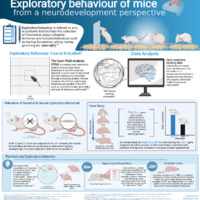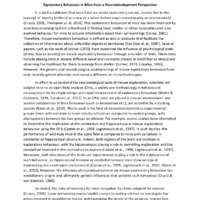Mouse Exploratory Behaviour From a Neurodevelopment Perspective
Item
- Title
- Source
- Rights
- Contributor
- Creator
- Description
- References
- Date
- Category
-
Mouse Exploratory Behaviour From a Neurodevelopment Perspective
-
ZOOL 567, Fall 2021.
-
Rosin, Jessica
Biorender.com
-
Festa, Tabitha
-
This is an infographic that describes the utility in studying mouse exploratory behaviour as a means to analyze nervous system development.
-
Archer, J. (1973). Tests for emotionality in rats and mice: A review. Animal Behaviour, 21(2), 205–235. https://doi.org/10.1016/S0003-3472(73)80065-X
Caston, J., Chianale, C., Delhaye-Bouchaud, N., & Mariani, J. (1998). Role of the cerebellum in exploration behavior. Brain Research, 808(2), 232–237. https://doi.org/10.1016/S0006-8993(98)00847-6
Crawley, J. N. (1985). Exploratory behavior models of anxiety in mice. Neuroscience & Biobehavioral Reviews, 9(1), 37–44. https://doi.org/10.1016/0149-7634(85)90030-2
Crusio, W. E., & van Abeelen, J. H. F. (1986). The genetic architecture of behavioural responses to novelty in mice. Heredity, 56(1), 55–63. https://doi.org/10.1038/hdy.1986.8
Crusio, W. E., Schwegler, H., & van Abeelen, J. H. (1989). Behavioral responses to novelty and structural variation of the hippocampus in mice. I. Quantitative-genetic analysis of behavior in the open-field. Behavioural Brain Research, 32(1), 75–80. https://doi.org/10.1016/s0166-4328(89)80074-9
Crusio, W. E., Schwegler, H., & van Abeelen, J. H. (1991). Behavioural and neuroanatomical divergence between two sublines of C57BL/6J inbred mice. Behavioural Brain Research, 42(1), 93–97. https://doi.org/10.1016/s0166-4328(05)80043-9
Crusio, W. E. (2001). Genetic dissection of mouse exploratory behaviour. Behavioural Brain Research, 125(1), 127–132. https://doi.org/10.1016/S0166-4328(01)00280-7
Laghmouch, A., Bertholet, J. Y., & Crusio, W. E. (1997). Hippocampal morphology and open-field behavior in Mus musculus domesticus and Mus spretus inbred mice. Behavior Genetics, 27(1), 67–73. https://doi.org/10.1023/a:1025667426222
Rosin, J. M., McAllister, B. B., Dyck, R. H., Percival, C. J., Kurrasch, D. M., & Cobb, J. (2015). Mice lacking the transcription factor SHOX2 display impaired cerebellar development and deficits in motor coordination. Developmental Biology, 399(1), 54–67. https://doi.org/10.1016/j.ydbio.2014.12.013
Tanaka, S., Young, J. W., Halberstadt, A. L., Masten, V. L., & Geyer, M. A. (2012). Four factors underlying mouse behavior in an open field. Behavioural Brain Research, 233(1), 55–61. https://doi.org/10.1016/j.bbr.2012.04.045
Thompson, S. M., Berkowitz, L. E., & Clark, B. J. (2018). Behavioral and neural subsystems of
rodent exploration. Learning and Motivation, 61, 3–15. https://doi.org/10.1016/j.lmot.2017.03.009
Van Daal, J. H. H. M., De Kok, Y. J. M., Jenks, B. G., Wendelaar Bonga, S. E., & Van Abeelen, J. H. F. (1987). A genotype-dependent hippocampal dynorphinergic mechanism controls mouse exploration. Pharmacology Biochemistry and Behavior, 28(4), 465–468. https://doi.org/10.1016/0091-3057(87)90507-7
Van Daal, J. H., Herbergs, P. J., Crusio, W. E., Schwegler, H., Jenks, B. G., Lemmens, W. A., & van
Abeelen, J. H. (1991). A genetic-correlational study of hippocampal structural variation and variation in exploratory activities of mice. Behavioural Brain Research, 43(1), 57–64. https://doi.org/10.1016/s0166-4328(05)80052-x
Walsh, R. N., & Cummins, R. A. (1976). The open-field test: A critical review. Psychological Bulletin, 83(3), 482–504. https://doi.org/10.1037/0033-2909.83.3.482
Walsh, J., Desbonnet, L., Clarke, N., Waddington, J. L., & O’Tuathaigh, C. M. P. (2012). Disruption of exploratory and habituation behavior in mice with mutation of DISC1: An ethologically based analysis. Journal of Neuroscience Research, 90(7), 1445–1453. https://doi.org/10.1002/jnr.23024
-
11/30/2021
-
Learning, Memory & Cognition.
- Item sets


